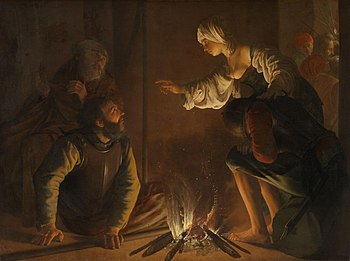The Denial of Saint Peter (Hendrick ter Brugghen)
| The Denial of Saint Peter | |
|---|---|
| Dutch: De verloochening van Petrus, French: Le reniement de saint Pierre | |
 |
|
| Artist | Hendrick ter Brugghen |
| Year | 1628 |
| Catalogue | A35, A30 |
| Medium | oil on canvas |
| Subject | Denial of Peter |
| Dimensions | 132.3 cm × 178 cm (52.1 in × 70 in) |
| Location | Art Institute of Chicago, Chicago |
| Accession | 1969.3 |
| Website | http://www.artic.edu/aic/collections/artwork/30901 |
The Denial of Saint Peter is a painting by Hendrick ter Brugghen, a member of the Dutch Caravaggisti, depicting Saint Peter's thrice denial of Christ as recounted in all four Gospels. It is thought to have been painted after 1625, and thus in the last three years of Ter Brugghen's life; he died in 1629. The painting shows a marked departure from Ter Brugghen's earlier painting in its emphasis on play of light, its baroque quality and a resolved sensibility.
The painting depicts a scene from the Denial of Peter as specifically recounted in the Gospel of Luke:
"And when they had kindled a fire in the midst of the hall, and were set down together, Peter sat down among them. But a certain maid beheld him as he sat by the fire, and earnestly looked upon him, and said, This man was also with him. And he denied him, saying, Woman, I know him not." Luke 22:55-57
The action takes place in an interior. Two soldiers are warming themselves around a fire, one evidently asleep, one rousing as a servant girl points at Saint Peter in the act of accusing him. He is cowering in the very left of the painting. Diametrically opposite and in a separate scene is Christ taken by soldiers. Their fence-like sticks echoes that of the soldier on the ground, the sticks in the fire, illuminating the scene, and the tent-pole or stick behind Peter and his accuser.
A figure stares out at the viewer from the scene of the taking of Christ. This scene is taken from Albrecht Dürer's Small Passion: Pilate Washing his Hands of 1512 where it is also used as a background motif and, in much the same way, implicates the viewer, through the staring soldier, in the foreground goings-on; there Pilate absolving himself, here Peter himself.
A painting in the Shipley Art Gallery in Gateshead, Tyne and Wear, England, attributed to Ter Brugghen, appropriates Dürer's composition directly and in reverse. This is again copied in another, nearly identical, painting by Ter Brugghen in the Lublin Museum, Poland.
...
Wikipedia
